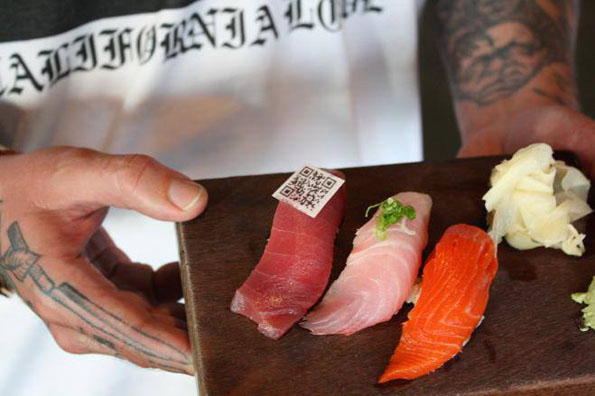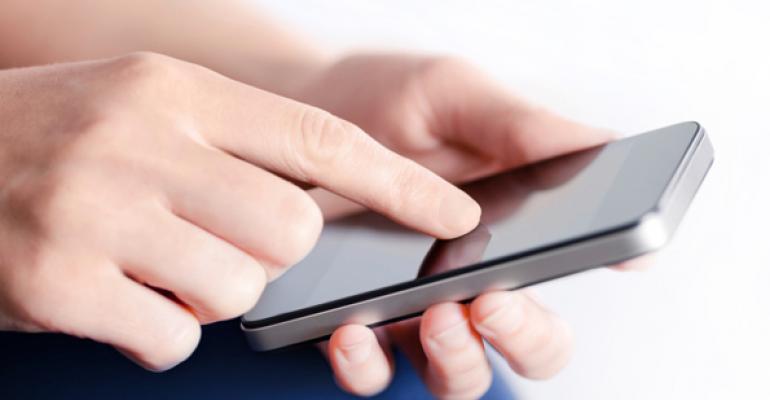Want to be able to communicate to customers that the seafood you serve is truly sustainable? Or would you be interested in an app that promises to streamline your restaurant’s order-taking process while ensuring that customers get exactly what they want? If you can count on a large number of your patrons having smartphones or tablets with them when they visit your restaurant, new QR code-based technologies can make applications like these possible.
A QR (Quick Response) code is a two-dimensional barcode that contains information that can be read by a smartphone’s camera. At San Diego sushi standout Harney Sushi, the restaurant uses water-based edible ink to print a QR code on rice paper, and then places those codes on top of individual pieces of sushi served to customers.
Those customers can then scan the code with their smartphone or tablet, which connects them to the National Oceanic and Atmospheric Administration’s FishWatch website. There they can check on the condition of the global stock of the particular species they’ve chosen to eat. Customers who want to dig deeper can also learn where the particular piece of fish they’re eating was caught, and perhaps see a picture of the fishermen who caught it.
The idea of serving customers a food item made of edible ink and paper is not new; hyper-creative Chicago chef Homaro Cantu first began using a similar system at his Moto restaurant in Chicago back in 2004. What’s different about the Harney Sushi approach is that it’s used to convey information in an interactive format about the product being served.

There’s no question edible QR codes are an interesting use of the technology. And they do emphasize the restaurant’s commitment to using sustainable fish. But what about the economic benefits? Does providing QR codes also help Harney Sushi sell more fish?
Harney Sushi executive chef Robert Ruiz tells National Geographic it does.
“We are growing faster than our projections. We have been record busy,” Ruiz says. “We have also noticed that people are now ordering more sashimi, more straight fish, I think because we’ve given them more confidence. If they were scared about trying some of the specialty fish, now they can scan the code and know everything we have is traceable.”
The upfront cost for Harney Sushi’s QR initiative was modest. Ruiz says the restaurant put $400 into the project to buy a printer capable of handling both edible rice paper and edible ink. We look forward to learning how other restaurant operators might use this technique while serving other kinds of food.
QR codes might prove to be useful in the dining room, too. A new app from Orlando, FL-based ezCommerce Solutions, dubbed Swift Server, enables customers to make menu choices and aggregate their orders on a smartphone or tablet prior to the arrival of their server. When everyone has decided what he or she wants, the app generates a QR code and the server scans the code off the customer’s phone. The system can be set up so diners can email their order to the kitchen, too. A bonus: because the order is customer-generated, every order is, theoretically, error-free.
“Mobile technology is making everyone’s lives more efficient on a daily basis,” says ezCommerce Solutions c.e.o. Naomi Wilson. “Why not bring that same level of efficiency to the foodservice industry? Diners can select from menu options, add their special requests, plug it into their phone and feel confident that their meals will show up at their tables correctly. Swift Server’s simplicity means that diners and restaurants can start using it today with no training and no implementation costs.”
Restaurant operators who want servers to upsell customers may not be in the market for Swift Serve, which discourages server-customer interaction at the time the order is placed. But in many restaurants, particularly where streamlined service and rapid table turns have high value, it could be a useful tool.
Right now, the Swift Serve app is free to restaurant operators. There will be a fee for upgrades to enhanced future versions of this app; there will continue to be a free version that will contain ads.
“In version 2.0, the restaurant will have the option to pay and have their menu loaded to the Swift Server database, which will produce a QR code, which will then be on their menus and load when the Swift Server user (the diner) scans the QR,” the company says. “Then the customer can order direct from the menu using the app.”
If your servers have smartphones, it might be worthwhile to experiment with this QR-based app to see how well it might function in your particular restaurant.





